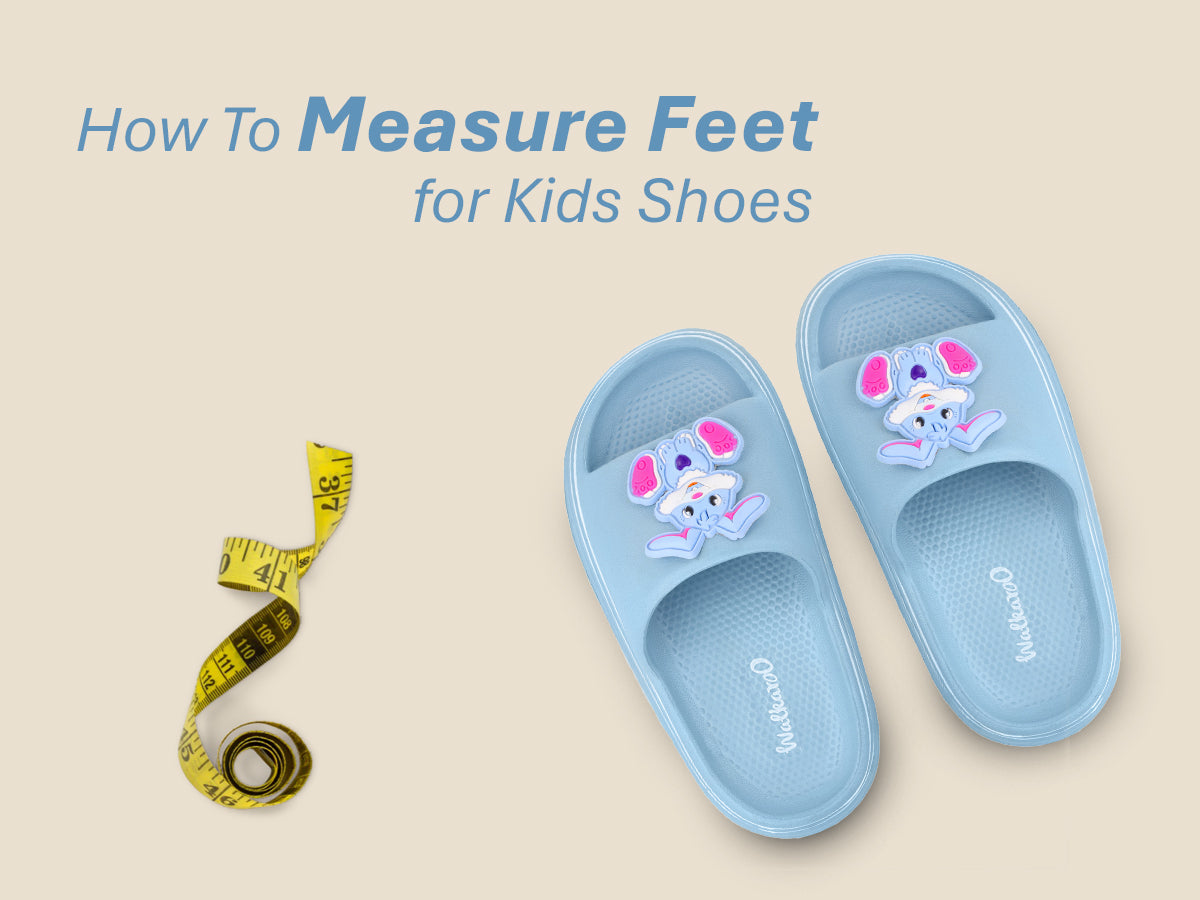Finding the right kids shoe size is crucial for your child's comfort and healthy foot growth. Ill-fitting shoes can cause blisters, foot pain, or long-term problems. This toddler shoe fitting guide shows parents exactly how to measure kid's feet at home and pick the perfect shoe size.
Why Measuring Kids Feet Matters
Children's feet grow rapidly, especially in the first few years. Choosing the wrong size can:
- Cause discomfort while walking or running
- Restrict proper foot development
- Lead to tripping or slipping
Measuring regularly ensures healthy foot growth, proper posture, and balance. It also helps parents avoid unnecessary foot problems caused by shoes that are too tight or too loose.
Simple Ways to Measure Kids Feet At Home
Accurate children's foot measurement is easy with just paper, a pencil, and a ruler. Follow these steps:
Step 1: Prepare the Setup
- Place a blank sheet of paper on a flat surface.
- Ask your child to stand straight with equal weight on both feet.
Step 2: Trace the Feet
- Hold a pencil upright and trace around each foot.
- Make sure the pencil does not tilt inward or outward.
- Always measure the larger foot for sizing.
Step 3: Measure Length and Width
- Use a ruler to measure from heel to longest toe for length.
- Measure across the widest part of the foot for width.
Step 4: Compare With Size Chart
- Check your measurements against a kids shoe size chart or brand-specific guide.
- If the foot lies between two sizes, choose the next size up to avoid tightness.
Tips For Accurate Kids Shoe Sizing
- Measure both feet; one may be larger.
- Take measurements in the evening when feet are slightly bigger.
- Measure while children are wearing socks.
- Leave a thumb-width gap in the shoe for movement.
- Check inside fit by pressing near the toes.
Common Mistakes Parents Make
- Guessing shoe sizes instead of measuring.
- Ignoring foot width differences.
- Using old measurements for months.
- Assuming all brands follow the same sizing.
Regular measurement prevents poor fit, foot pain, and tripping hazards.
How Often Should You Measure Kids Feet?
- Every 2-3 months for younger children (rapid growth).
- Twice a year for older children.
- Keeping track of sizes ensures comfort, stability, and longer-lasting shoes.
Choosing the Right Shoe after Measuring
Once the foot size is known, focus on shoe quality and comfort:
- Soft, flexible soles
- Good cushioning and breathability
- Adjustable straps or laces for a perfect fit
- Lightweight design for active movement
Even the best shoes won't help if the fit is wrong.
Toddler Shoe Fitting Guide for Growing Feet
- Toddlers need shoes with extra toe room and flexible soles.
- Comfort should come before fashion; proper growth matters more than style.
- Use a toddler shoe fitting guide to balance safety, comfort, and style.
Kids Shoe Size Chart (Example)
|
Foot Length (cm) |
US Size |
UK Size |
EU Size |
|
10.5 - 11.0 |
3 |
2.5 |
18 |
|
11.1 - 11.7 |
4 |
3.5 |
19 |
|
11.8 - 12.4 |
5 |
4.5 |
20 |
Always check brand-specific charts as sizes may vary.
Conclusion
Measuring kids feet at home is simple but essential. Always measure both feet, compare measurements to a sizing chart, and leave space for comfort. With regular measurement and attention to quality, children's shoes will support healthy growth, comfort, and active movement.
Popular Searches:
Kids Footwear | Kids Shoes | Boys Shoes | Girls Shoes | Kids Sandals | Boys Sandals | Girls Sandals | School Shoes | Kids School Shoes | Boys School Shoes | School Shoes for Girls.
FAQs
1. How can I measure my child's feet at home to determine shoe size?
Place your child on paper, trace both feet, and measure length and width with a ruler.
2. How often should I measure my child's feet?
Every 2-3 months for toddlers and at least twice a year for older children.
3. Should I measure both feet?
Yes, because one foot is usually larger than the other.
4. What time of day is best for measuring a child's feet?
Evening is ideal, as feet are slightly larger after a day of activity.
5. What are signs that my child's shoes are too small or too big?
Look for red marks, tightness, tripping, or slipping inside the shoes.




Share:
White Sneakers vs Black Sneakers: Which is the Best Choice for You?
How to Polish Shoes to a Mirror Shine: Step-by-Step Guide